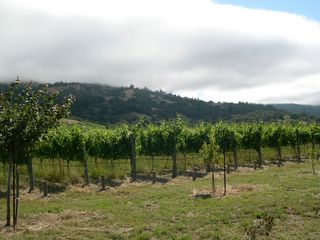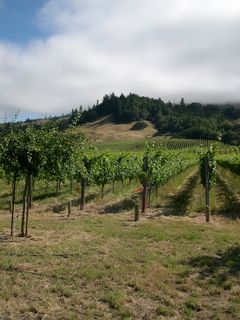Yeast and diversity in wine
- Doug Tunnel, Brick House Vineyards (Oregon)
Just because the French vocabulary is defective and doesn't have a word for winemaker doesn't make that fact a good basis for an argument about how to make wine - does it? I mean Spanish doesn't have a word specifically for "winery"...so what?
But it’s an interesting thought; wines made in one region are different because of the natural yeast flora in their cellars as opposed to other regions – or even other producers within the same region. It’s quite romantic, but it’s not necessarily true. And if the above is true, why pay winemakers at all?
Yeast as Terroir
Would yeast contribute to terroir? Certainly it can be argued that it’s one component of what has been called terroir, but it’s a part of the larger subject of winemaking.
Weather, viticulture decisions and winemaking styles all influence the final wine. Whether to add yeast is an expression of the winemaker’s intentions and vision. However, it’s pretty doubtful that by using yeast from Napa I could disguise a wine made with grapes from the Dundee Hills in Oregon. Other winemaking decisions that were made, as well as the climate and viticulture would still be more influential than simply the choice of yeast I think. If that's not right, then Napa would be up a creek (sorry about the pun) as everyone in the world would use yeasts isolated there to produce wines that rivaled the originals (that was the idea with the original yeast collections in Burgundy and Bordeaux). Then there’s yet another question to be asked: how many consumers – or even serious wine collectors – would be able to tell the difference between two wines, one made with indigenous yeast and the other with commercially available yeast if they weren’t first alerted to that fact? Would they then prefer the indigenous yeast wine? Perhaps not universally...
And are those differences retained in the wine throughout its life, or are they transient in nature?
Monocultures, and risk management
Some argue (as above) that monocultures of yeast reduce desired complexity and produce homogenized (read here as “predictable”, “flat”, “unexciting”, “dull”) flavors and aromas. If over-used, and if you can entertain a vision of the entire wine world using but a single yeast regimen, then yes that would be a poor future. But it would also be a rather interesting failure of human innovation and imagination, and would require the prior homogenization of all human tastes in wine (culturally, and perhaps physically as well).
Reality is a bit different than that scenario.
Yeast monocultures (commercial yeast preparations) have been around for over 100 years in brewing, and over 70 in winemaking. C’mon now, shouldn’t the homogenization of flavors and aromas already have taken place – if it was going to take place at all?
In all that we have seen in the last century as far as increased diversity of wine styles and increased wine quality, is it reasonable to assume that suddenly humanity would lose sight of individuality and taste differences to adopt a single yeast to do all of its wine fermentations?
NO…I don’t think so.
Collection and propagation of wine yeast culture was originally done to preserve and to promulgate the styles of wines crafted by the great French Chateaux, and was carried out by French university professors back in the 1930’s (back in Steiner’s day, interestingly enough). The specimens collected were undoubtedly of mixed organisms, and were more than likely to have had variable results when applied. Some components of the original flora may have died during handling and storage to leave the more robust genera to dominate when finally pitched. There would have been no way for the yeasts purchased to have really been representative (in a viable sense) of what was in the winery where they were collected – and therefore no way for them to have possibly made the same wine as the original chateau where they were harvested – if indeed the premise is true that the driving reason for their final character was the indigenous yeast of the cellar they were made in…
That premise is of course central to the whole debate of indigenous vs. “commercial” yeasts, but falls apart when vinicultural styles and individuality of the winemaker are introduced to the equation, not to mention the differences in fruit sourcing.
In the end, I ask myself “do the French then have themselves partly to blame for what now is railed against by le petite artisane vigneron?” [see Cultured Yeast, Wine Business Monthly, for some interesting viewpoints]
The answer to that is yes, but I wouldn’t disallow the French to change their minds.
The problems with spontaneous (indigenous) ferments are the variability. Some years may be good, while other years, with say late rains which help strip yeast from the fruit, may have problems getting started. Pitching a commercial yeast culture decreases the chances of failure, allows for more wine to be of increased quality, and decreases the price the consumer pays by reducing the amount of substandard wine produced and decreasing waste. Pitching a few pounds of a quality known yeast into a 10-ton vat with the grapes you just paid $50,000 alone for is insurance and piece of mind that you haven’t just committed yourself to the poor house (it's always easier for people to call for indigenous ferments when it's NOT their money in the tank!). Less lag time for other nasty organisms to establish themselves means better chances of not having lactic or acetic bacteria screw up your wine. There’s also a case to be made that a population of known S. carlbergensis will help to ferment to dryness and thereby make your wine less likely to be a breeding ground for Brettanomyces…it would be an interesting study to see what proportion of the wines which test positive for Brett later in their lives were actually fermented with indigenous yeasts compared to pitched commercial yeasts. Guess I just found my next homework project…
Progress
That commercial yeast strains have flourished in the last 30~40 years is part of the progress of mankind and technology. The incidence of ferments which stop when we don’t want them to is down. Greater numbers of yeasts and variations of those strains have been identified. The ability to enhance varietal aromas by choice yeast selections, or to decrease the amount of alcohol that would otherwise result from fermentations [Aussie modified yeast link], or degrade malic acid [Mauri yeast] without producing creamy or buttery notes, or a host of other alternative production variables can all now be part of the selection process.
This has led to MORE diversity in the wines humanity makes, with greater variability…
Some have even forged ahead with co-fermentations where several strains of “pure” yeasts have been added simultaneously to ferment side by side, or sequentially added during different stages of the ferment. The “cold soaking” of musts for a few days prior to actual fermentation has also potentially played a hand in the selection and promotion of cryo-tolerant yeasts during the first few days, populations of which also play a hand in the final wine profile.
It seems to me that progress in this case is a much desired thing.
Labels: biodynamic, terroir












